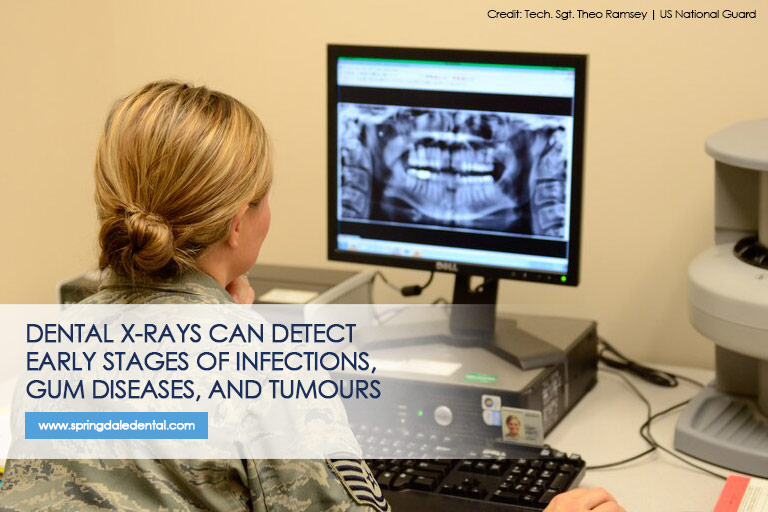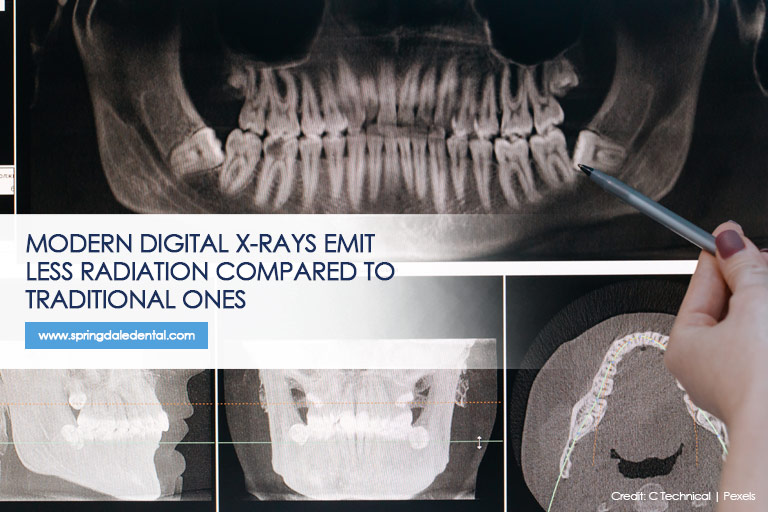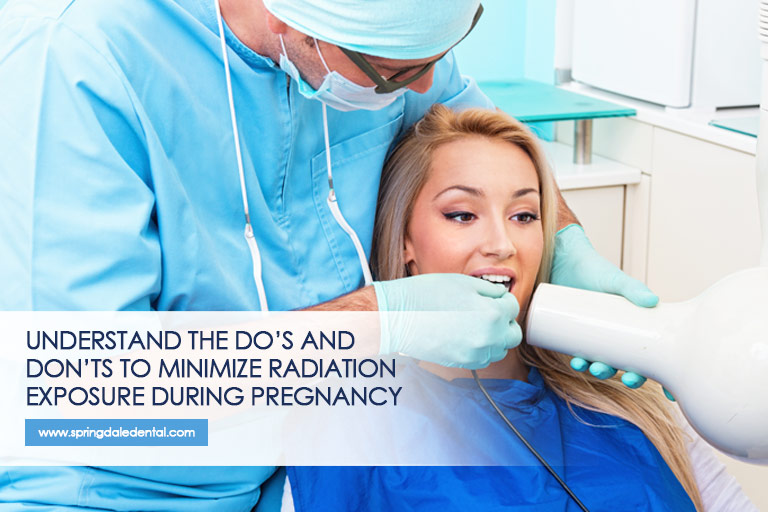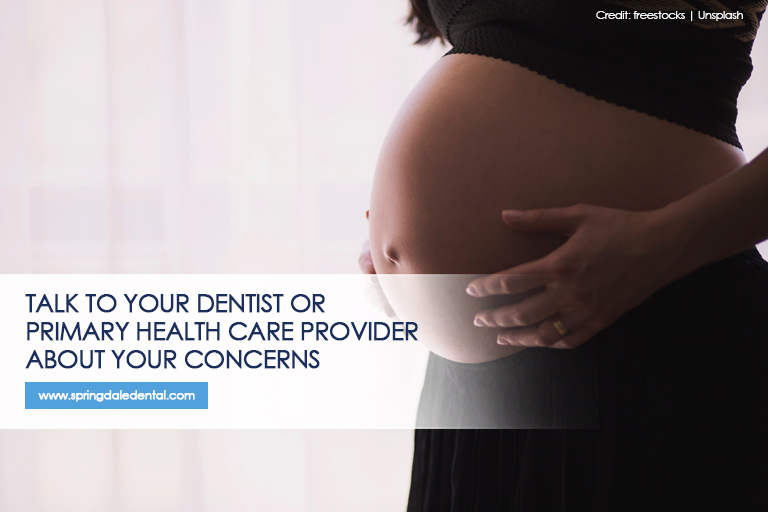When you are pregnant, your body goes through enormous changes. It is also during this time when doctor appointments become a crucial part of your routine. However, another crucial step you need to take is visiting your dentist. Fortunately, having a dental checkup during pregnancy is not something for you to worry about. It’s completely safe.
Your dentist can help you in case you are experiencing any gestation-related dental symptoms. At some point, during your dental visit, it is likely for you to have dental X-rays. It’s understandable to feel anxious, but a dental X-ray when pregnant causes zero harm to a fetus. The benefits of dental X-ray diagnostic information outweigh the possible risk.
According to the Canadian Dental Association, X-rays for pregnant patients are safe, given that safety measures — like a lead apron, thyroid collar, and high-speed film — are used during the exam. Have peace of mind when going to your dentist by having a clear understanding of dental X-ray safety.
Understanding X-Ray Radiation

An X-ray is a quick, painless procedure that yields images of your body’s internal structures, particularly the bones, through electromagnetic radiation. It passes through the body and is absorbed in different amounts depending on the density of each body structure. Your teeth and bones are incredibly dense compared to soft tissue. This produces high-contrast images and makes them appear white on an X-ray film. Cracks in teeth or bones appear grey.
High-level radiation can pose risks to pregnant women. The good news is: X-rays produce low amounts of radiation and are safe.
Radiation Amounts in Dental X-Rays

X-ray radiation being absorbed in the body is measured in millirad or rad (1 rad is equivalent to 1000 millirads). According to studies (PDF), exposing a fetus to more than 10 rad increases the risk for eye problems, birth defects, and malformation. However, the majority of musculoskeletal X-rays (an X-ray not aimed at your chest or abdomen) are weaker and expose a fetus to a small-scale of a rad fraction.
The allowed cumulative dose of radiation for pregnant women is 5 rad — there is not a single diagnostic exam that exceeds this limit.
Dental X-rays produce the following amounts of radiation:
- Full mouth series, a complete set (18 images) of intraoral X-rays
- 0.0388 rad – D-speed film*
- 0.0035 rad – PSP (or F-speed film) and rectangular collimation**
- 0.0171 rad – PSP (or F-speed film) and round collimation
- 0.0017 rad – CCD sensor (estimated) and rectangular collimation
- 0.0085 rad – CCD sensor (estimated) and round collimation
- Bite wing, a total of 4 images showing the crowns of the upper and lower teeth
- 0.0005 rad – PSP (or F-speed film) and rectangular collimation
- Dental cone-beam computed tomography (CBCT), detailed 3D dental X-rays of teeth, soft tissues, nerves, and bones typically used when regular dental X-rays are not enough
- 0.0011 to 0.0674 rad – Dentoalveolar CBCT small and medium field of view***
- 0.0030 to 0.1073 rad – Maxillofacial CBCT with large field of view
* D-speed film is the slowest speed class; the F-speed film is the fastest.
** Collimation refers to limiting the size of the radiation beam to minimize exposure. Rectangular collimation has the lowest exposure risk.
*** Field of view (FOV) is the size of the exact area in the body included in a scan. Smaller FOVs have a lower risk of radiation exposure.
To be exposed to dangerous levels of radiation that can put your unborn baby at risk, you need about 128 full mouth series X-rays (with D-speed film) and 46 Maxillofacial CBCT X-rays (which includes imaging of the face, jaws, and neck).
Potential Effects of a Dental X-ray

Fetuses are extremely sensitive to external factors including radiation, alcohol, drugs (illegal or prescribed), and infection. Since dental and medical visits are necessary during pregnancy, there are concerns regarding radiation. While there are scientific disputes regarding small quantities of X-ray radiation potentially harming a fetus, this is only partly true. While developing in the womb, fetal cells grow and divide quickly into specialized tissues and cells. Radiation exposure can disrupt the process resulting in possible illnesses or birth defects.
However, apart from environmental factors, childhood illnesses and birth defects can be caused by other factors including:
- Genetics
- Socioeconomic factors
- Infections
- Maternal nutritional deficiency
Scientists are aware that hazards in the developmental process are multifold and cannot be entirely attributed to radiation via X-rays. As long as exposure does not exceed the maximum acceptable amount of 5 rad, your baby is in no danger of any ill effects of radiation.
How to Reduce Risks During Dental X-Rays

While there is an insignificant risk from a single X-ray exam, you need to take safety measures to protect your unborn child.
- Tell your dentist or X-ray technician in advance if you are (or might be) pregnant.
- Keep a detailed record of your X-ray history. This includes the type of exam, date it was taken, referring doctor, and facility where the X-ray is stored. Inform your dentist or doctor to avoid any unnecessary duplication of the procedure on the same body part.
- Ask your dentist to use E or F-speed films for their X-rays. Compared to D-speed films, E and F films are faster and have lower radiation doses while having similar benefits and near-identical costs.
- Wear a lead apron or shield. Even if the X-ray is not directed at your abdomen, ask if you can wear a lead apron or a similar shield. This will protect you from the possible risks to your reproductive organs even if you are not pregnant.
- Schedule dental visits during the 2nd trimester. Significant fetal development occurs in the 1st trimester and the 2nd half of the 3rd trimester. Limit dental X-rays and treatment in the 2nd trimester to protect your baby.
- Postpone non-emergency procedures until after the pregnancy. For dental emergencies like a dislodged tooth or gum injury, seek dental help immediately, but procedures like teeth whitening and certain orthodontic treatments can wait.
- Inform your dentist if you are undergoing radiation therapy. the radiation amount you are getting if you are under radiation therapy, as well as the level of radiation exposure your baby received. You might want to seek assistance with a medical physicist about the schedule and type of radiation therapy.
X-Rays Prior to Knowing You Are Pregnant

In rare instances where the expectant mother is not aware of their pregnancy, there is a higher risk if they undergo several X-rays on the abdomen or lower torso over a brief period.
Fortunately, dental X-rays have extremely low radiation doses and are directed in areas away from the womb. There is almost no chance of its affecting your pregnancy. However, if you have had a variety of X-rays at the hospital while you are pregnant, you should still inform your dentist so they can postpone your dental exam.
X-Rays While Breastfeeding
Generally, after you have given birth and when you start breastfeeding, X-ray tests are safe. Even if a contrast (a temporary dye used in imaging procedures) is taken, the amount of contrast passed on to your baby through your breast milk is minuscule and poses no risk.
While this brings no cause for concern, it is still best to let your dentist, doctor, and technician know if you are breastfeeding. They can assess the situation better and recommend other courses of action, like whether to postpone the test or to alter your breastfeeding schedule.
We understand if you are skeptical about getting a dental X-ray or other dental procedures while you are pregnant. Consult your dentist so they can give you a better understanding of any potential risks and the safety measures they implement to minimize them.
Turn to Springdale Dental Centre for exceptional dentist in Brampton. We will give you advice and walk you through the X-ray process so you do not have to worry about your baby. Call us at 905-458-1212 or book an appointment by filling in our Contact Us form.



